Migraines are a debilitating neurological condition affecting millions worldwide. If you or a loved one suffers from migraines, understanding their causes, triggers, symptoms, and treatment options can significantly improve quality of life. This guide explores the science behind migraines, practical management strategies, and emerging therapies to help you take control of your condition.
What Are Migraines?
Migraines are primary headaches that occur independently rather than as a symptom of another condition. They involve intense, throbbing pain, typically on one side of the head, and are often accompanied by nausea, vomiting, and sensitivity to light and sound. Severe migraines can last hours or even days, severely impacting daily life.
Phases of a Migraine:
Migraines typically progress through four phases:
- Prodrome: Occurs up to 48 hours before the headache, with symptoms such as mood swings, food cravings, neck stiffness, and fatigue.
- Aura: Not everyone experiences this phase, but it may involve visual disturbances (flashes of light, zigzag lines) or sensory symptoms like tingling.
- Headache Phase: Characterized by intense throbbing pain, nausea, and light and sound sensitivity.
- Postdrome: After the headache subsides, sufferers may experience fatigue, mental fog, and lingering sensitivity to light and sound.
Common Migraine Triggers & How to Manage Them
Migraine triggers vary by individual, but common factors include environmental, dietary, and lifestyle influences.
Environmental Triggers
- Weather Changes: Sudden shifts in temperature, humidity, and barometric pressure can trigger migraines.
- Strong Smells: Perfumes, cleaning products, and food odors can be potential triggers.
- Bright or Flickering Lights: Reducing screen time and using anti-glare filters can help minimize exposure.
Dietary Triggers
- Caffeine: Both excessive intake and withdrawal can provoke migraines.
- Alcohol: Red wine, beer, and aged spirits containing histamines and tyramine are common culprits.
- Food Additives: MSG, nitrates (found in processed meats), and artificial sweeteners can be problematic.
Lifestyle Triggers
- Sleep Disturbances: Maintain a regular sleep schedule to prevent migraine onset.
- Stress: Practice relaxation techniques like meditation or mindfulness to reduce stress-induced migraines.
- Physical Exertion: Avoid overexertion, as intense exercise may trigger attacks.
Practical Management Tips
- Keep a Migraine Diary: Track triggers, symptoms, and lifestyle habits to identify patterns.
- Make Gradual Changes: Implement small but impactful adjustments, such as reducing caffeine intake or improving sleep habits.
Recognizing Migraine Symptoms
While severe, throbbing head pain is the hallmark symptom, migraines involve more than just pain.
Accompanying Symptoms
- Nausea & Vomiting: Ginger tea or anti-nausea medications can help alleviate these symptoms.
- Cognitive Symptoms: Brain fog and difficulty concentrating can persist during and after an attack.
- Aura Symptoms: Visual disturbances (flashes of light, blind spots) and sensory issues (tingling, numbness) may precede the headache phase.
Conventional Migraine Treatments
A combination of medications and lifestyle changes is often the most effective approach.
Acute Treatments
- Over-the-Counter Pain Relievers: Ibuprofen, aspirin, and acetaminophen can help manage mild migraines.
- Triptans: Prescription medications like sumatriptan and zolmitriptan help reduce symptoms by narrowing blood vessels.
- Anti-Nausea Medications: Medications such as metoclopramide can help those who experience nausea with migraines.
Preventive Treatments
- Beta-Blockers: Propranolol helps prevent migraines by stabilizing blood pressure and heart rate.
- Antidepressants: Amitriptyline can help regulate neurotransmitter activity to reduce migraine frequency.
- Anticonvulsants: Medications like topiramate or valproate are prescribed for chronic migraine prevention.
Emerging and Innovative Therapies
New treatments are offering hope to those who struggle with conventional options.
Neuromodulation Techniques
- Transcranial Magnetic Stimulation (TMS): Uses magnetic pulses to stimulate brain areas involved in migraines.
- Cefaly Device: A wearable device that delivers electrical stimulation to reduce migraine frequency.
New Medications
- CGRP Inhibitors: Erenumab and similar drugs block the CGRP molecule involved in migraine attacks.
- Gepants & Ditans: New oral medications with fewer side effects than traditional triptans.
Lifestyle Innovations
- Ketogenic Diet: Some individuals experience reduced migraine frequency on a high-fat, low-carb diet.
- Supplements: Magnesium, riboflavin (B2), and coenzyme Q10 may support migraine prevention.
Lifestyle Adjustments for Migraine Prevention
Incorporating simple lifestyle changes can help minimize migraine frequency.
- Prioritize Sleep: Maintain a consistent sleep schedule to avoid triggering attacks.
- Stay Hydrated: Dehydration is a known trigger, so drink enough water daily.
- Manage Stress: Yoga, meditation, and breathing exercises can help reduce migraine onset.
Living with Migraines: Real-Life Success Stories
Emily’s Journey
Emily, a marketing manager, discovered that weather changes and stress were major migraine triggers. By tracking her symptoms and using triptans for acute relief and beta-blockers for prevention, combined with yoga and mindfulness, she significantly reduced her migraine episodes.
John’s Success with Neuromodulation
John, an engineer suffering from chronic migraines, found relief using the Cefaly device after several failed medication attempts. His migraine frequency decreased by 50%, improving his overall quality of life.
Take Control of Your Migraines Today
Migraines are complex, but with the right knowledge, you can take charge of your condition. By identifying triggers, seeking appropriate treatments, and making lifestyle changes, you can reduce migraine frequency and severity.
Your Next Steps:
- Keep a Migraine Diary: Track your symptoms and triggers to find patterns.
- Consult a Healthcare Provider: Discuss your options for medications and alternative treatments.
- Explore Lifestyle Adjustments: Implement dietary and stress-reduction strategies to prevent attacks.
Takeaway Message
Migraines are complex and individualistic, but understanding their triggers, symptoms, and available treatments is the first step toward better management. By identifying personal triggers, using appropriate treatments, and making lifestyle adjustments, migraine sufferers can take control of their condition. Whether through medication, emerging therapies, or alternative treatments, there are multiple pathways to achieving relief.
Resources for Further Learning
- American Migraine Foundation – https://americanmigrainefoundation.org
- National Headache Foundation – https://headaches.org
- Migraine Research Foundation – https://migraineresearchfoundation.org
- Cefaly (neuromodulation device) – https://www.cefaly.us
If you or someone you care for is suffering from migraines, it’s important to consult with a healthcare provider to find the best treatment plan. By combining medical expertise, practical lifestyle adjustments, and a strong support network, it’s possible to live well despite migraines.
